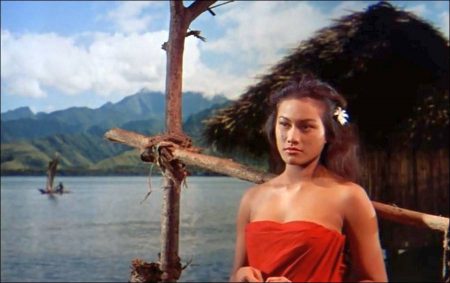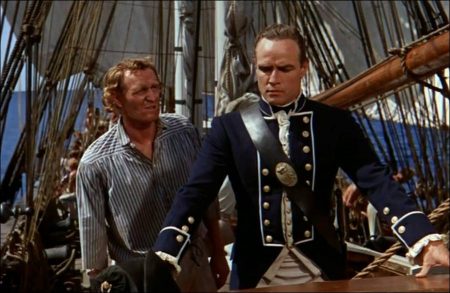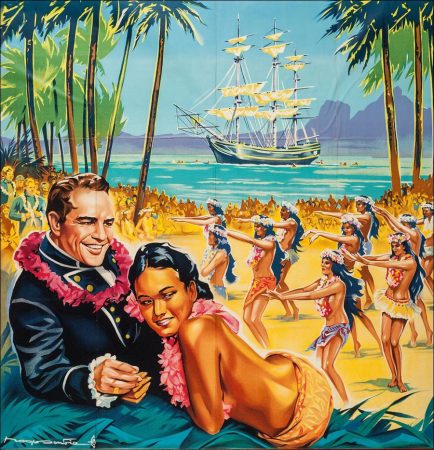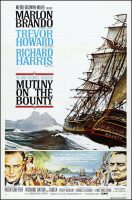Mutiny on the Bounty movie storyline. Based on a true story: The Bounty, a British sailing ship commanded by Captain Bligh sails for Tahiti to pick up breadfruit plants and take them to Jamaica where they are to be planted and help supply the British with a compact, easy to grow, nutritious plant. Lt. Christian is the executive officer – that is, second in command of the vessel.
The ship proceeds south with the intention of rounding Cape of Good Hope, Africa and proceed via the Indian and Pacific Ocean to the Tahitian islands. Captain Bligh is pressed for time since he must get to Tahiti while the plants are transportable. He decides to cut 5 months off the journey by going around Cape Horn (South America) instead. However, he encounters typical horrible weather and is unable to make the transit. He then reverses course (to the east) and goes to Tahiti via the originally intended route. This diversion costs more time and pretty much guarantees he will be late in arriving in Tahiti which will require staying there until the plants are transportable (perhaps 6 months).
During all this time, Bligh is abusing his men and officers in various ignoble and demeaning ways. He explains his foul behavior to his exec (Mr. Christian) that fear is the only thing seamen understand and this justifies general cruelty and abuse. The sadistic details are numerous and do not advance the plot except to set the stage for the eventual mutiny.
After an idyllic stay in Tahiti (the exec, Mr. Christian, is ordered by Bligh to ‘sleep with’ the Tahitian chief’s daughter to avoid insulting the chief) the ship laden with a thousand plants sets sail for Jamaica. More abuse and cruelty ensues on this leg of the trip – mostly as a result of Bligh restricting water to the crew in order to feed the plants (many would otherwise die, says the onboard gardner).
Finally Mr. Christian snaps and takes command of the ship and sets Bligh and a few seamen adrift midocean in a boat with enough provisions to last a while (they do make it back to England where Bligh is acquitted of wrongdoing in a naval trial but is scolded). Christian, now in command of returns to Tahiti, picks up a few of the native guys and gals and wanders the ocean looking for a good hiding place and discovers Pitcairn Island which is uninhabited and in the middle of nowhere and mislocated on the naval charts (Google it).
Mutiny on the Bounty is a 1962 American Technicolor epic historical drama film released by Metro-Goldwyn-Mayer, directed by Lewis Milestone and starring Marlon Brando, Trevor Howard and Richard Harris. The screenplay was written by Charles Lederer (with uncredited input from Eric Ambler, William L. Driscoll, Borden Chase, John Gay and Ben Hecht), based on the novel Mutiny on the Bounty by Charles Nordhoff and James Norman Hall. Bronisław Kaper composed the score.
The film tells a fictionalized story of the real-life mutiny led by Fletcher Christian against William Bligh, captain of the HMAV Bounty, in 1789. It is the second American film to be based on the novel, the first being Mutiny on the Bounty (1935), also produced by MGM.
Mutiny on the Bounty was the first motion picture filmed in the Ultra Panavision 70 widescreen process. It was partly shot on location in the South Pacific. Panned by critics, the film was a box-office bomb, losing more than $6 million.

A working replica of the Bounty was built in Nova Scotia at a cost of $750,000 and was sailed to Tahiti. It took nine months to make rather than the scheduled six and arrived after filming had started. Shooting was supposed to begin in October 1960, however delays in the scripting and construction of the ship meant it did not begin until November. More than 150 cast and crew arrived in Tahiti, and MGM took over 200 hotel rooms.
Shooting began on November 28. Filming was difficult, in part because the script was being rewritten and Brando was reportedly ad-libbing much of his part. Costs were also high due to the remote location. However Marlon Brando later wrote “realities surpassed even my fantasies about Tahiti, and I had some of the best times of my life making Mutiny on the Bounty… Every day, as soon as the director said “cut” for the last time, I ripped off my British naval officer’s uniform and dove off the ship into the bay to swim with the Tahitian extras working on the movie. Often we only did two or three shots a day, which left me hours to enjoy their company, and I grew to love them for their love of life.”
In January 1961, after three months of filming, Reed flew back from location with an “undisclosed ailment”. This has been reported as gallstones and heat stroke; other reports said Reed was unhappy over differences over the direction of the story. By now, the rainy season had started. Filming halted and the unit returned to Hollywood. MGM demanded that Reed finish the film within 100 days. Reed said he needed 139. The studio fired him. Brando claims in his memoirs that MGM fired Reed because he wanted to make Bligh the hero.
All about Mutiny on the Bounty 1935 movie.
Mutiny on the Bounty (1962)
Directed by: Lewis Milestone
Starring: Marlon Brando, Trevor Howard, Richard Harris, Hugh Griffith, Richard Haydn, Tarita Teriipaia, Matahiarii Tama, Percy Herbert, Duncan Lamont, Gordon Jackson, Chips Rafferty
Screenplay by: Charles Lederer
Cinematography by: Robert L. Surtees
Film Editing by: John McSweeney, Jr.
Costume Design by: Moss Mabry
Set Decoration by: Henry Grace, Hugh Hunt
Art Direction by: George W. Davis, J. McMillan Johnson
Music by: Bronisław Kaper
MPAA Rating: None.
Distributed by: Metro-Goldwyn-Mayer
Release Date: November 8, 1962
Visits: 297



